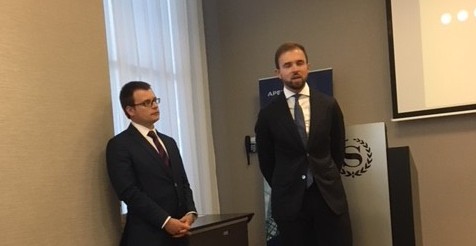Bakir Lashkari & Michel Klompmaker
De bijeenkomst in het Sheraton Hotel Airport rond de recente ontwikkelingen over de economische sancties tegen Iran en Rusland, georganiseerd door Wladimiroff Advocaten in samenwerking met Aperio Intelligence, werd goed bezocht door professionals. De gastheer Sebastiaan Bennink verzorgde de introductie en begon te spreken over de US Economic sanctions versus Iran.
Tijdens het seminar, echt voor de specialisten, kwamen onder andere de volgende maatregelen aan de orde en die werden telkens door Sebastiaan toegelicht:
* US Withdrawal from the JCPOA
* Extra-territoriality of the US Iran sanctions regime
* Food, agricultural commodities, medicine and medical devices
* EU Response
* Implications for European companies
Over de geschiedenis en de huidige stand van zaken:
JCPOA
– On 14 July 2015, the E3/EU+3 (China, France, Germany, Russia, UK, US and the EU) and Iran announce agreement on a Joint Comprehensive Plan of Action. Iran agreed to limit its nuclear program to peaceful purposes only, in return of a comprehensive lifting of all nuclear-related UN, EU and US sanctions.
– On 16 January 2016, Implementation Day, following the IAEA‘s verification that Iran had executed its commitments under the JCPOA.
– Various stages of sanctions relief over the course of the next 8 years.
– US and EU non-nuclear sanctions remain in full force and effect.
– If Iran violated the JCPOA, a 65-day “snap back” process would apply.
Extra-territoriality of the US sanctions regime expands
– US secondary sanctions concern extraterritorial measures under which the US can penalise a non-US person, without any ties or nexus to the US, for engaging in specified activities relating to a sanctioned country or sanctioned persons.
– Secondary sanctions do not require a US Nexus to be triggered: “Non-U.S. persons that “materially support” sanctioned entities/persons could…”.
Vervolgens begon Sebastiaan de actuele situatie en terugtrekking van US van JCPOA te adresseren en de zaal luisterde zeer aandachtig naar zijn professionele en boeiende verhalen over de Primary Sanctions and Secondary Nexus Sanctions.
US Withdrawal from the JCPOA
– The JCPOA was not negotiated as a treaty, since it would have required the approval of the Senate. Due to this fact, Congress passed a bill into law in 2015, the Iran Nuclear Agreement Review Act. This Act requires the US President to certify the JCPOA every 90 days in order to ensure that Iran remains in compliance with the agreement.
– On 13 October 2017, President Trump decertified Iran’s compliance with the JCPOA threatening to leave the deal.
– On 8 May 2018, President Trump announced the US’ withdrawal from the JCPOA and to begin re-imposing
– The US Government will reinstate secondary sanctions against Iran in two phases following a 90-day and 180-day wind-down period ending 6 August and 4 November 2018, respectively.
– US secondary sanctions will largely revert to their pre JCPOA levels, posing risks for non-US companies that have invested in key sectors of the Iranian economy since 2016.
– OFAC will re-expand US primary sanctions by revoking:
– Specific licenses granted for the sale of commercial passenger aircraft and related parts and services (90 days);
– General License I, which authorizes contracts related to such sales (90-days); and
– General License H, which authorizes certain activities by US-owned or controlled foreign entities (180-days).
Key issues
On 6 August 2018 the 90-day wind-down period ends. Sanctions re-imposed related to:
– USD;
– Gold and precious metals;
– Raw/semi-finished metals, coal, graphite;
– Software for integrating industrial processes;
– Significant transactions related to the purchase or sale of Iranian rial;
– Trade in Iranian sovereign debt; and
– Iran’s automotive sector.
On 4 November 2018 the 180-day wind-down period ends. Sanctions re-imposed related to:
– Ports; shipping; shipbuilding sector;
– Oil and petrochemical transactions;
– Operations between foreign FI’s and CBI or Iranian FI’s;
– Underwriting, insurance and reinsurance services;
– Specialised financial messaging (Swift); and
– Iran’s energy sector.
Also, the US will re-impose sanctions against persons removed from the SDN-list (including most, not all, banks).
NB. On 27 June 2018 GL I and GL H have been revoked, but transactions falling under these licenses authorized to wind-down.
Extra-territoriality of US sanctions regime expands
Asset Freezes
– Property of SDNs, or owned /controlled parties (50% rule), is blocked when it is in the US or comes within the possession or control of a US person.
– US person may not make any contribution or provision of
funds, goods or services by, to or for the benefit of any person whose property or interests in property are blocked.
– US person may not receive any contributions or provision of
funds, goods or services from any blocked person.
50% Rule
The 50 percent rule is how OFAC determines whether entities that are not listed on the SDN/SSIL list are subject to blocking or sectoral sanctions because they are owned by other entities or individuals who do appear on the SDN/SSIL list.
The property of an entity can be subject to blocking or sectoral sanctions, even if the entity is itself not listed as an SDN/SSIL, when such entity is:
– Owned;
– Directly or indirectly;
– Up 50% or more;
– By one or more (aggregated);
– Parties that are subject to blocking/sectoral sanctions.
Food, agricultural commodities, medicine and medical devices
US Iran sanctions regime allows sales of food, agricultural commodities, medicine, and medical devices to Iran by non-US persons.
The financing or facilitation of such sales by non-US persons does not trigger sanctions, so long as the transaction does not involve certain US-designated persons (such as IRGC or a designated Iranian bank).
The conduct or facilitation of payments for such sales by foreign banks is not subject to US sanctions when the payments originate from accounts of the CBI or from accounts of Iranian commercial banks that have not been designated by the US.
EU Response
I. On 9 May 2018 –Regret. Declaration by the High Representative on behalf of the EU following US withdrawal.
II. On 4 June2018 –Request.
– to grant exemptions from US sanctions for EU companies;
– to grant extended and adapted wind-down periods;
– to confirm that the secondary sanctions will not apply to specific sectors, such as food, agricultural commodities, medicine and medical devices;
– to grant exemptions for key sectors and in particular in the fields of energy, automotive, civil aviation and infrastructure; -prolong General License H;
– to grant exemptions to maintain banking channels and financing channels with Iran and the preservation of financial messaging services (SWIFT) to these banks; and
– to reaffirm the exemption for Embassy bank accounts.
III.On 6 June 2018 –Reaction. The EU Blocking Regulation.
– Update of Council Regulation (EC) No 2271/96of November 1996. EU’s response to US extraterritorial sanctions against Cuba, Iran and Libya.
– The update is subject to a two-month approval period, meaning that it could come into force on 6 August 2018, the same day as the end of 90-day wind-down period.
– Prohibits compliance with the covered US Iran sanctions unless formally authorised by the EU Commission;
– Prohibits recognition or enforcement of US court/administrative decisions giving effect to the covered US Iran sanctions; and
– Provides for the possibility to recover any damages (including legal costs) caused by the application of the covered US Iran sanctions.
Implications for European companies
Expectation that the EU Blocking Regulation has limited potential for effectively countering US secondary sanctions since:
– Enforcement of the EU Blocking Regulation by the EU member states has been virtually non-existent;
– Catch-22. Either comply with EU law and violate US sanctions, or comply with the US sanctions in violation of EU law;
– Large(r) European companies have already started to wind down their Iran related transactions;
– FI’s unwilling to facilitate Iran related financial transactions, because of their US presence;
– Serious problems to arrange effective compliance measures.
Recent developments force many companies into an unattractive choice between US and EU compliance.
1.What regime applies EU law/US law/other and what is your exposure in the US?
2.Apply layered approach:
– Know your customer and your customer’s customer/end-user;
– Know your product or service (sanctions/export controls);
– Know the transaction.
3. Check all information against applicable sanctions.
4. And, furthermore:
– Ensure that agreements are sanctions-proof;
– Be transparent vis-a-vis authorities and financial institutions; and
– Know how to respond in case of an incident.
De Aperio consultant George Voloshin opende zijn verhaal met US/EU sancties tegen Rusland met als titel: “A New Era For Sanctions: What Do They Imply?” Halverwege van de presentatie schakelde Aperio consultant over en ging hij nader in op de verschillen en de impact van de sanctiemaatregelen versus Rusland en Iran.
Er werden interessante vragen gesteld over de impact van de US-sancties tegen bedrijven onder andere over de US zusterbedrijven die in de EU operationeel zijn en met Iran zaken doen. Tijdens de discussies en vragen, bleek dat niet alleen de economische sancties maar ook de politieke implicaties een belangrijke rol spelen bij de conflicten tussen de US en EU ten aanzien van Iran en Rusland. Het seminar was een belangrijk aanzet en zal een vervolg krijgen, maar wat is next? Dat weet nog niemand en met name wat er exact gaat gebeuren met de sancties en de impact daarvan tegen Iran en Rusland! Een beetje koffiedik kijken, misschien iets te veel.
Economic Sanctions: The Trump Effect, what is Next?
24 juli 2018


